How America's fast food has changed over the decades
How food got fast

Think fast food, and it’s likely that a handful of world-beating burger brands spring to mind. While the idea of ‘fast’ food (that is, food that can be eaten quickly on the go) can be traced all the way back to ancient civilisations, the version we know and love today is a proudly American invention with roots in the 20th century. Here we step back in time to take a look at how fast food restaurants in the USA and Canada evolved from coin-operated machines and hot dog stands to shiny, modern drive-thrus and high-tech ordering systems.
Click or scroll through our gallery and feast your eyes on some of the oldest images of fast food that exist today.
1910s: the original fast food restaurant
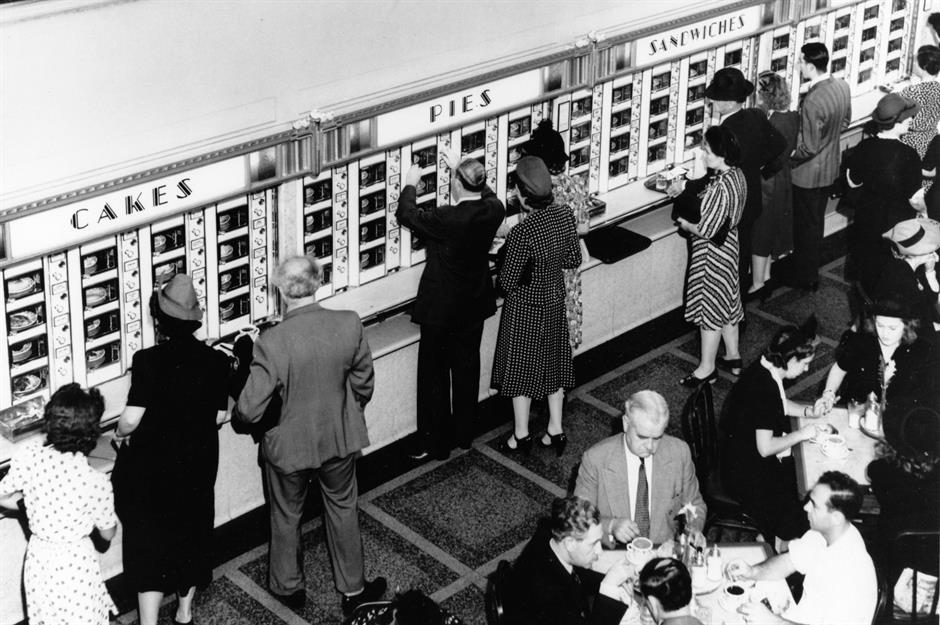
When the first Horn & Hardart Automat appeared in New York City in 1912, it heralded a new culinary culture. Credited as America’s first fast food chain, the company was revolutionary at the beginning of the 20th century for letting diners serve themselves from coin-operated vending machines. Famous for its very affordable prices and freshly brewed drip coffee, Horn & Hardart had more than 100 locations between New York and Philadelphia at its peak, and weekday workers could get everything from sandwiches and salads to pies and cakes.
1910s: the New York hot dog is born
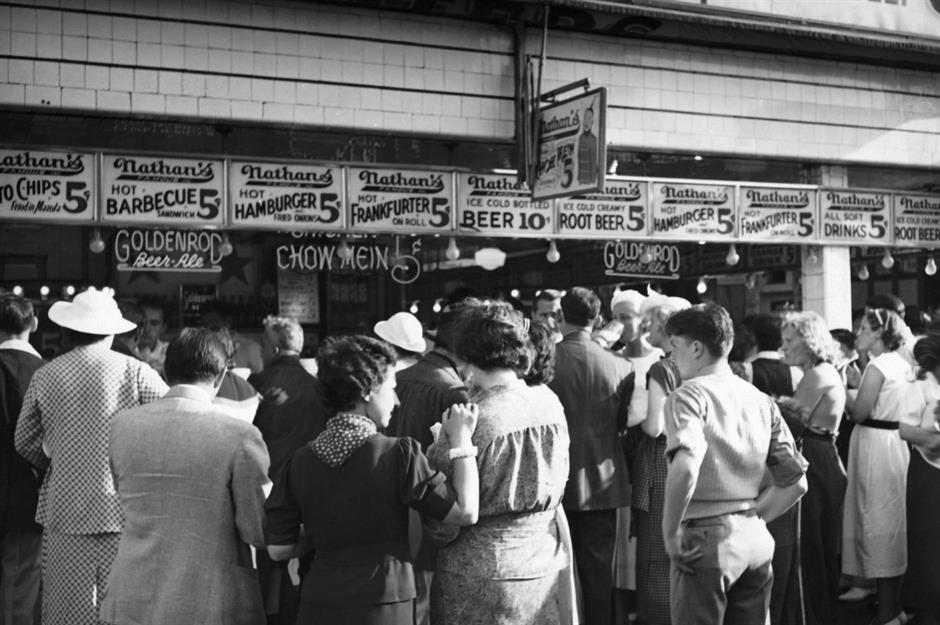
The quintessential New York hot dog stand, Nathan's Famous was founded in 1916 by Nathan Handwerker, a Polish immigrant. He had previously worked at Feltman’s German Gardens (a large restaurant on Coney Island known for its hot dogs) and decided to start his own rival business. Nathan opened his hot dog stand on Coney Island, New York, selling hot dogs for just five cents each, undercutting his former employer's price of 10 cents.
1920s: Nathan gets famous
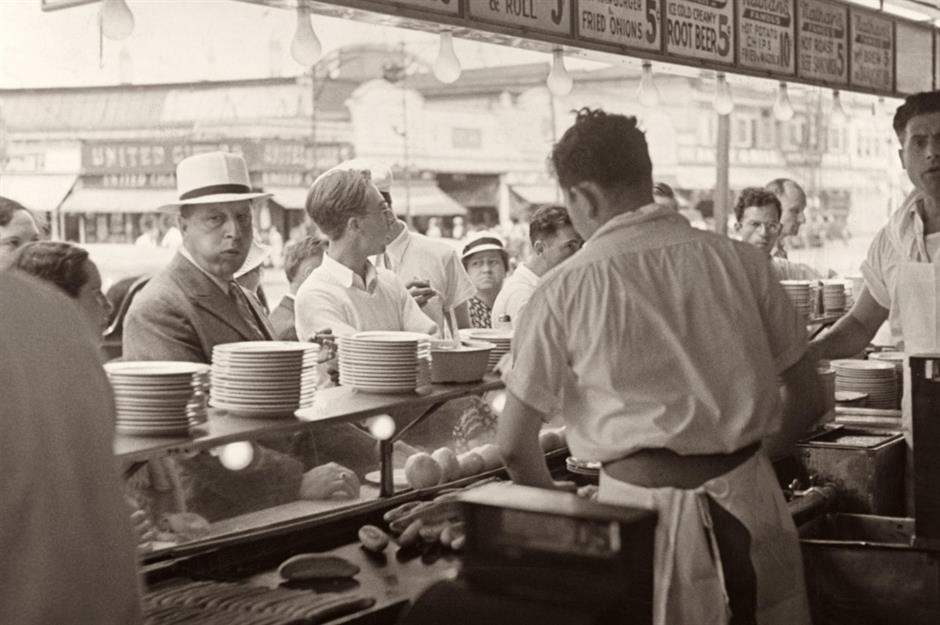
Nathan's quickly gained popularity due to its affordable prices, prime location and quality hot dogs (made to a secret recipe created by his wife Ida), becoming a staple for both locals and visitors to Coney Island. The stand also attracted famous personalities, including Al Capone and Cary Grant, which helped boost its reputation. After expanding to a second restaurant in 1955, it slowly grew to become one of the most recognisable hot dog brands in the country.
1920s: America's first burger chain
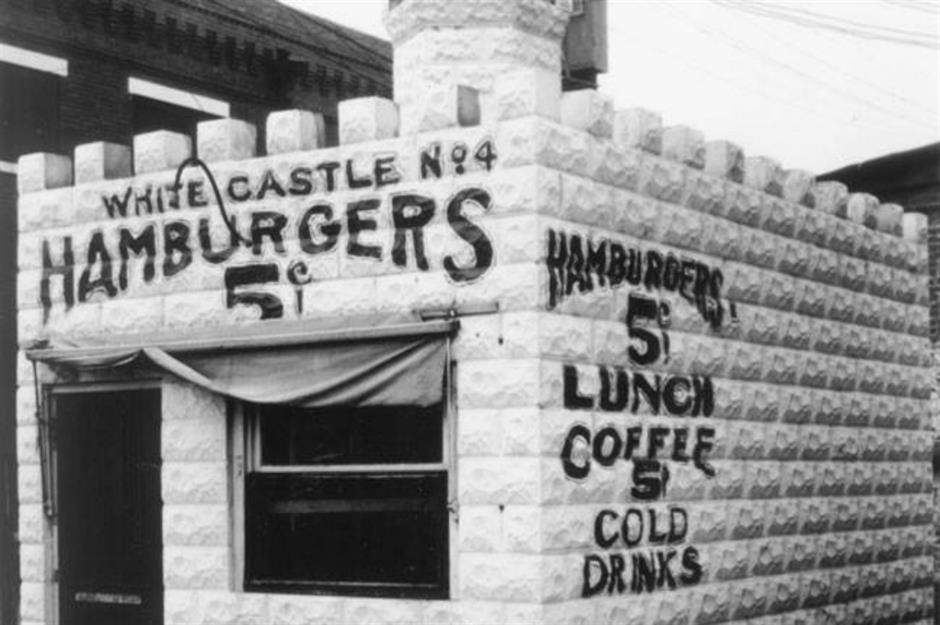
While hot dogs and automats were making waves on America’s East Coast, down in the Midwest an even faster food was emerging – the burger chain. As McDonald’s dominates today, it might be a surprise to learn the firm wasn’t the first in the game. Many believe the first US fast food burger chain was White Castle. In 1921 in Wichita, Kansas, founders Walt A Anderson and Edgar Waldo 'Billy' Ingram set out to change the public's perception of the quality of the meat industry.
1920s: burgers are in business
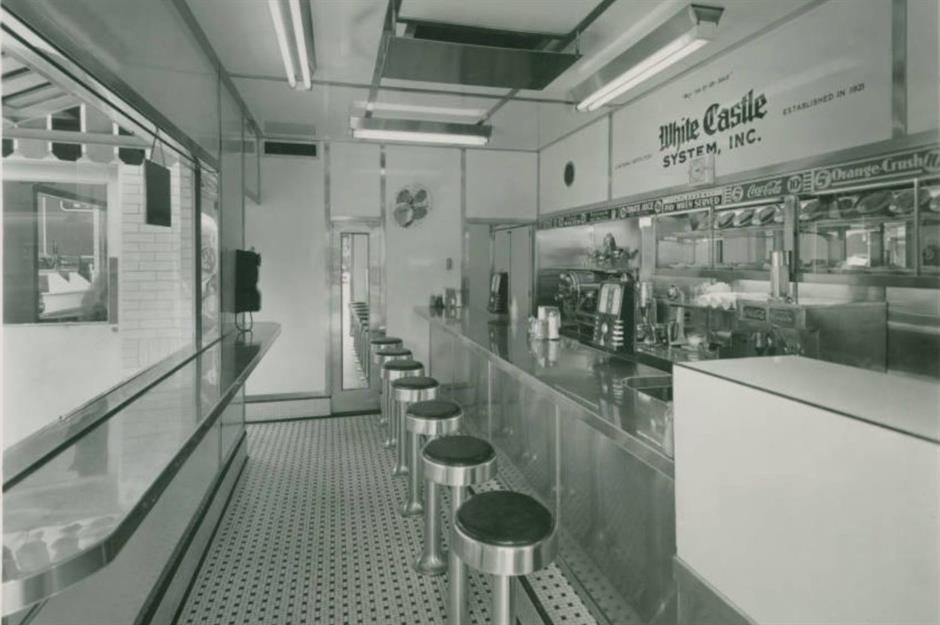
The idea of cleanliness was key. White Castle introduced open kitchens in its bright-white and stainless-steel restaurant, and staff wore spotless uniforms. Its restaurants still look like little white castles today, and it’s still going strong with its Original Slider – a square patty in a bun that's often named the most influential burger of all time. Oh, and it might have invented the takeout burger too. Expansion was slow and steady, but by the 1940s White Castle had become a household name around the Midwest.
1930s: the rise of the diner
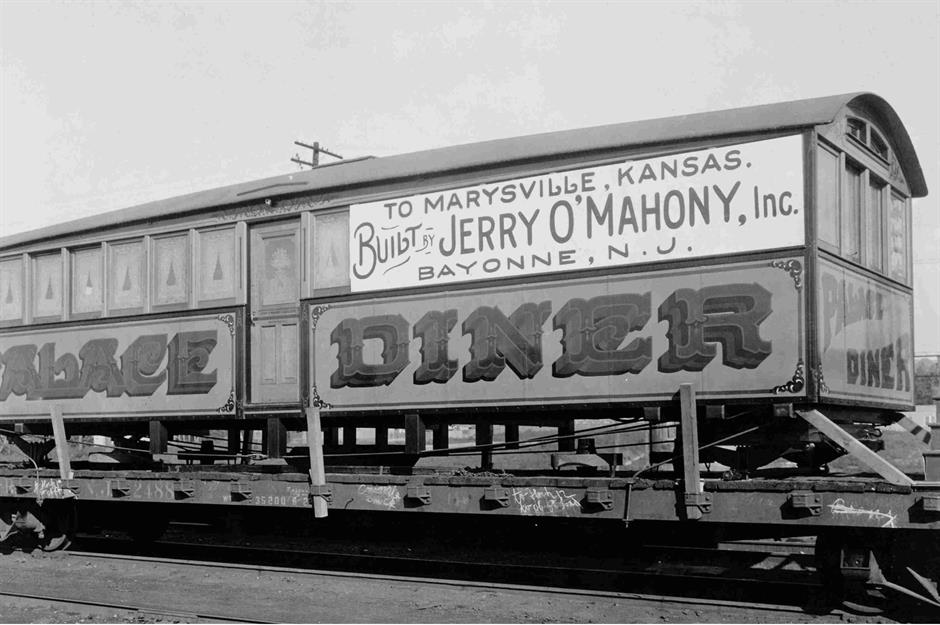
Ordering a burger and milkshake at a shiny, all-hours diner is a quintessential part of American life. Diners boomed in the USA as the country returned to prosperity after World War II, and as the age of the motorcar gave rise to the suburbs. However, diners, and their iconic stainless-steel exteriors, first appeared in the first half of the century.
1930s: cheap eats
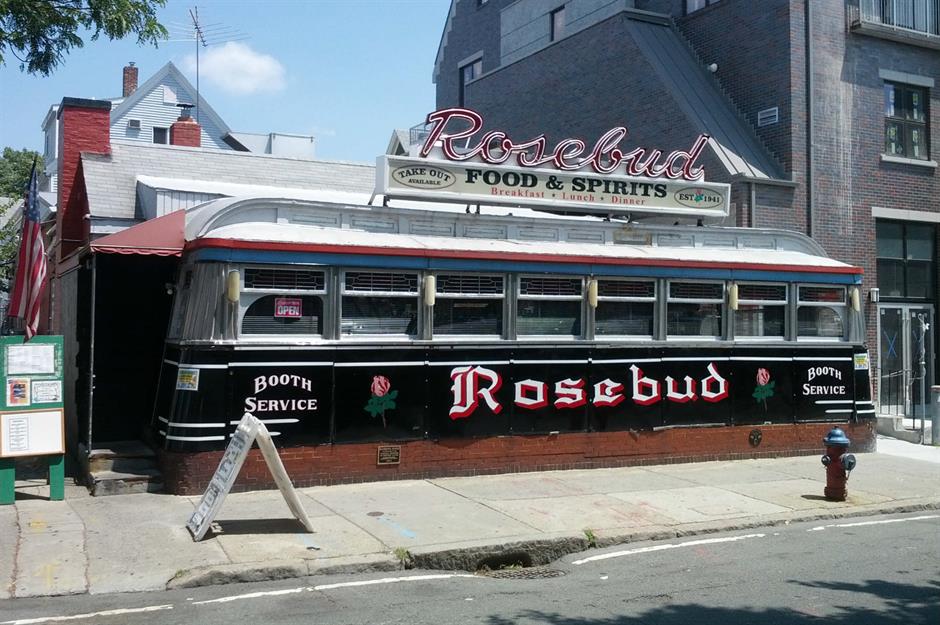
The first diners were actually static rail dining cars or lunch wagons, which could be moved along to ply their trade in different locations – like a food truck today, but with seating. These gave way to cheap, quick-to-set-up prefabricated buildings. But these new mass-produced diners retained the classic wagon look. Some, like the Rosebud in Somerville, Massachusetts, built in 1941 by the Worcester Lunch Car Company, are still in business.
1930s: Canada's first drive-in
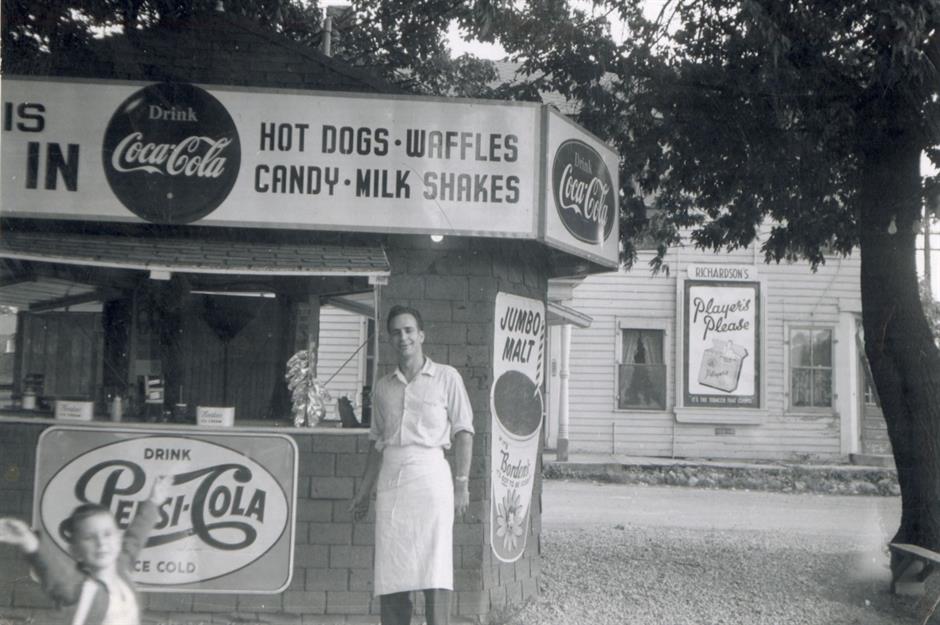
The concept of the USA-style diner spread to Canada in the early 20th century, particularly as railroads expanded and travellers sought quick, hearty meals at stops along their routes. Opened in 1927, Oasis Drive-In in Caledonia, Ontario is considered the country’s oldest drive-in diner and is still going strong today. These joints sold American staples like all-day breakfasts, burgers and sandwiches alongside regional comfort food. In Quebec, diners often incorporated French Canadian staples like tourtière, pea soup and poutine, while diners in the Maritime provinces featured seafood-heavy menus, with dishes like fish and chips and chowder taking centre stage.
1940s: timeless design
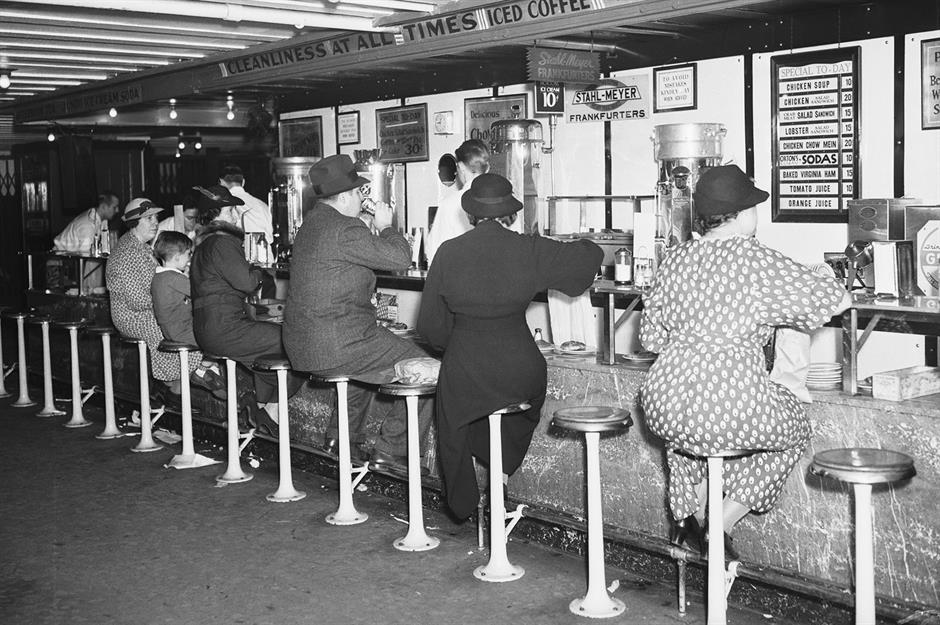
Most diners have retained that unique retro design, as it became part of the American cultural landscape. You know what you’re looking at and what to expect inside. You get good value, classic booths, table service and a simple menu of quick-cook American classics, such as hamburgers, fries, club sandwiches and, of course, endless coffee.
1940s: fast food for everyone
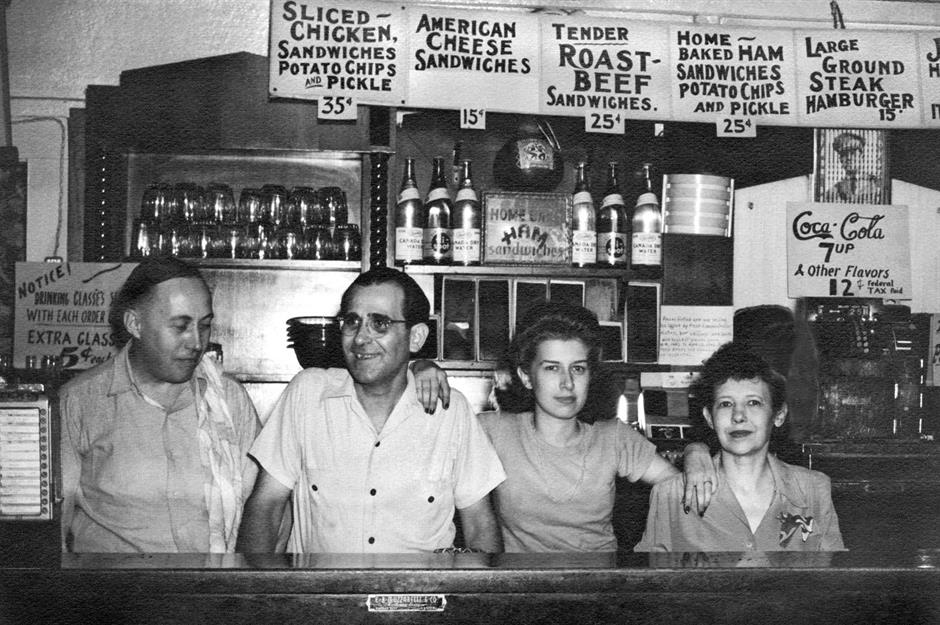
The epitome of the American Dream, diners are usually small businesses that cater to all sections of society. And as the diner established itself as a cornerstone of American culture, it became about a lot more than comfort food and a cup of coffee. From feeding hungry families and shift workers to being a haven for teens to meet up, the diner was becoming a place that fostered community spirit – something that was especially important during the wartime years. In this photo from 1940, a close-knit team of diner staff smiles for the camera.
1940s: humble beginnings
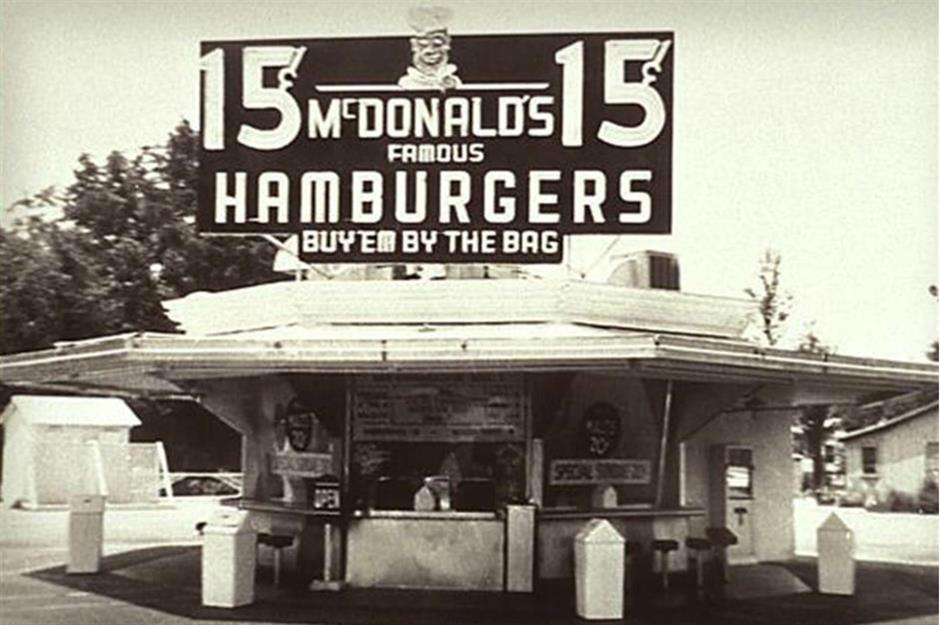
However, it would be two working-class brothers who would take fast food beyond the American Dream to conquer the globe. Richard and Mac McDonald opened McDonald’s Bar-B-Q in San Bernardino, California in 1940. Like at other drive-in restaurants, carhops delivered meat sandwiches and peanut butter and jelly sandwiches to customers' cars. But then the brothers had a better idea. In 1948, they closed the restaurant and reinvented it with a simple nine-item menu.
1940s: speeding things up
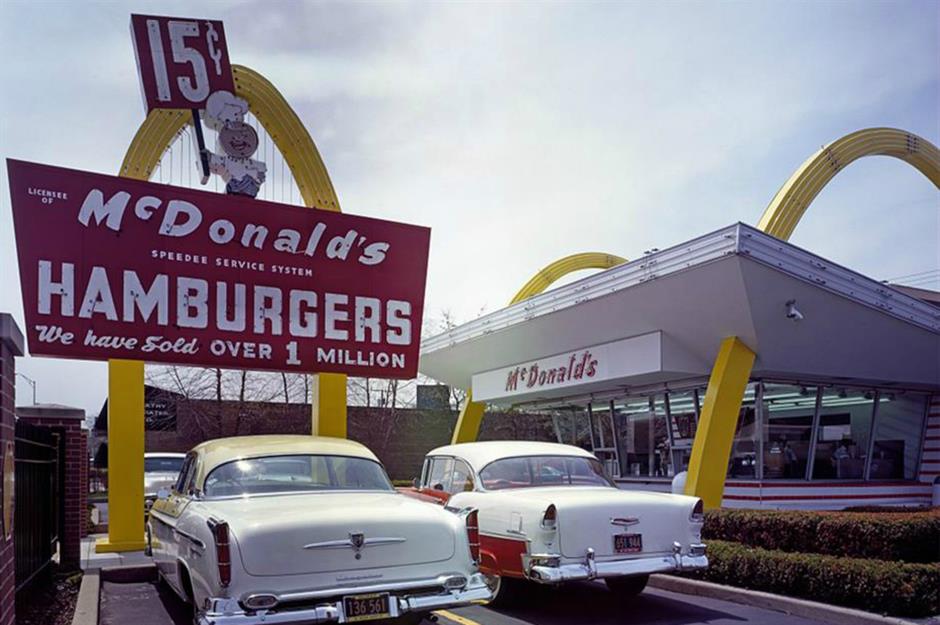
The brothers' secret was speed. To get orders ready in '30 seconds, not 30 minutes', in 1948, Dick rebuilt their service area. He marked up a tennis court as their kitchen and made staff act out their jobs until he’d found the most efficient method.
1940s: Speedee the mascot
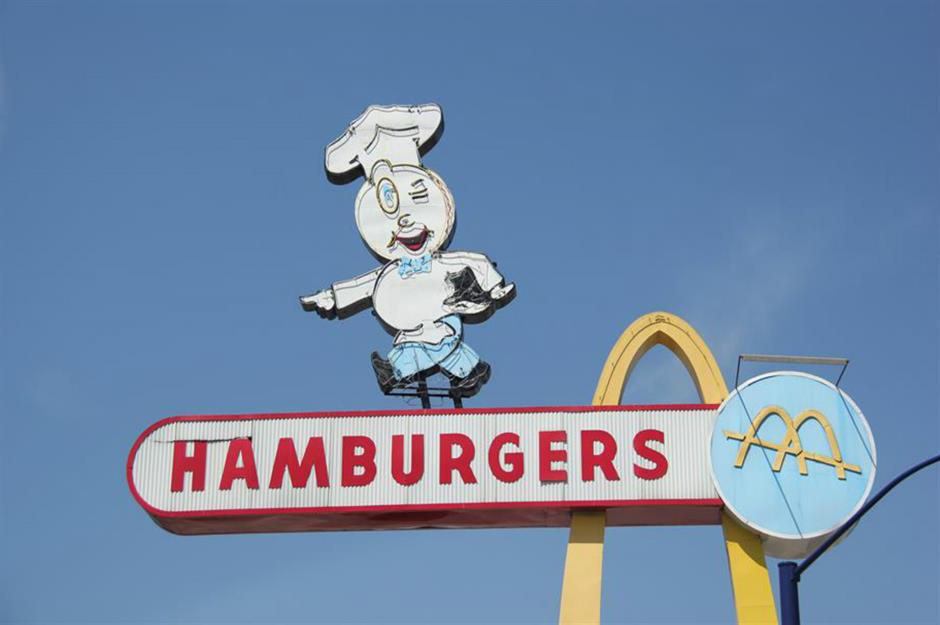
A mascot, a mini chef called Speedee, was raised aloft the newly redesigned restaurant. The natty little fellow, dressed in a quietly patriotic outfit, was part of McDonald’s brand, along with the Golden Arches, until 1955. Ronald McDonald didn’t come on the scene until almost a decade later, in 1963.
1940s: drive-in becomes drive-thru

Just as McDonald’s was reinventing the burger business its own way, another fast food innovation was already underway: the drive-thru. The firstcomer’s prize goes to Red’s Giant Hamburg (yes, without the 'er' due to a mismeasured sign). Opened in 1947 in Springfield, Missouri, its owner Sheldon 'Red' Chaney got fed up with life as proprietor of a small gas station and decided to put his herd of beef cattle to better use. He opened a restaurant on the site of the gas station forecourt and sold hamburgers to busy travellers passing through.
1940s: fast food, California style
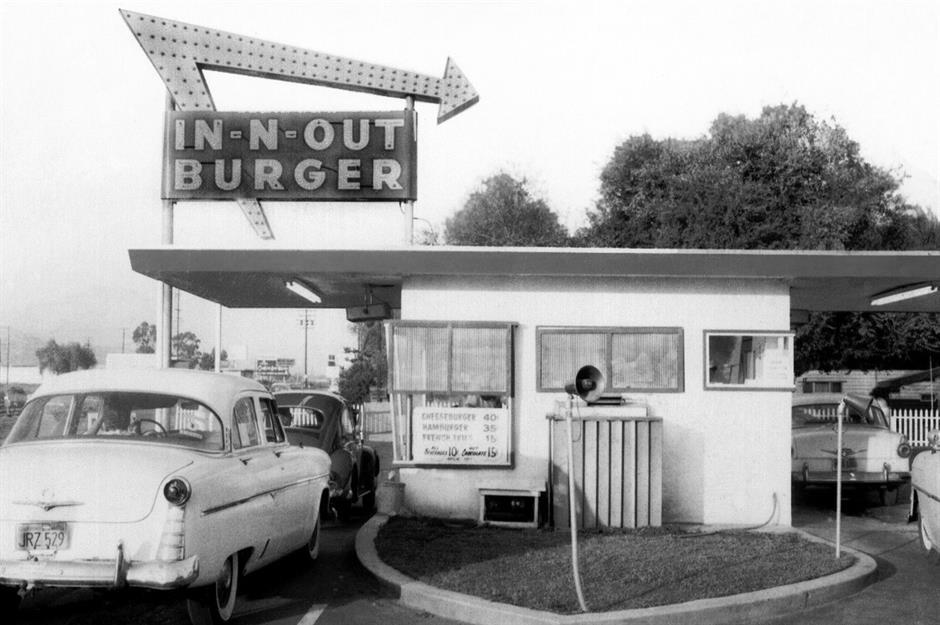
The very next year, the same concept would start a chain: the snappily named In-N-Out Burger, which was opened by Harry and Esther Snyder in the Los Angeles suburb of Baldwin Park, California. Wanting to serve the best burgers at his sparkly clean new burger stand, Harry would visit the meat and produce markets himself, and prepare the food by hand. Esther, meanwhile, did the accounts in their home around the corner. In-N-Out Burger is still a family business today.
1940s: can I take your order?
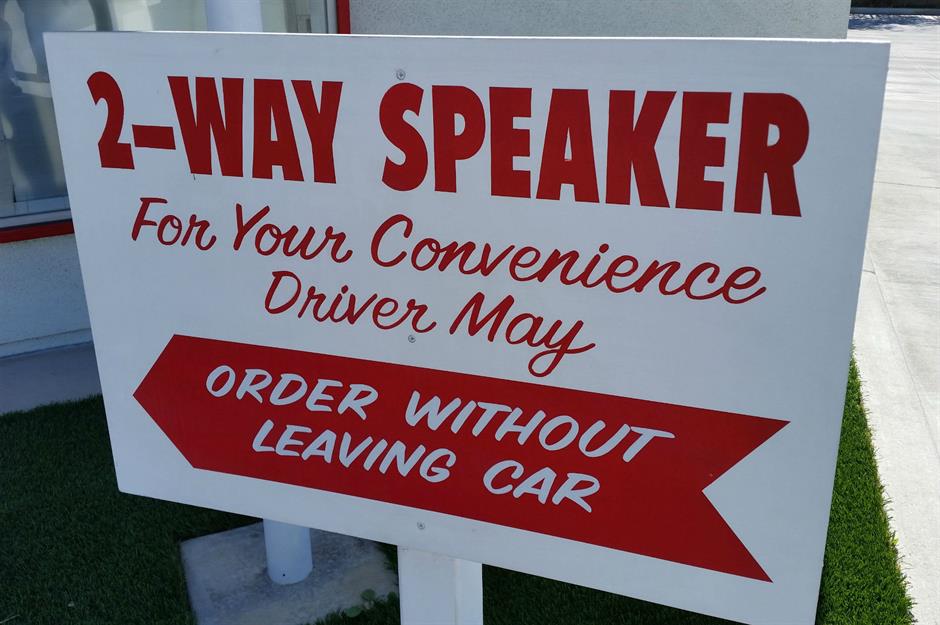
To fulfil his vision of letting customers order from inside their cars, Harry worked in his garage at night, after spending all day in the kitchen, to create his unique two-way speaker box, single-handedly upping the burger chain game in 1948. A replica of In-N-Out Burger's early speaker sign is pictured. Next time you drive up and speak into the little box, remember to salute good ol' Harry.
1950s: America runs on Dunkin'
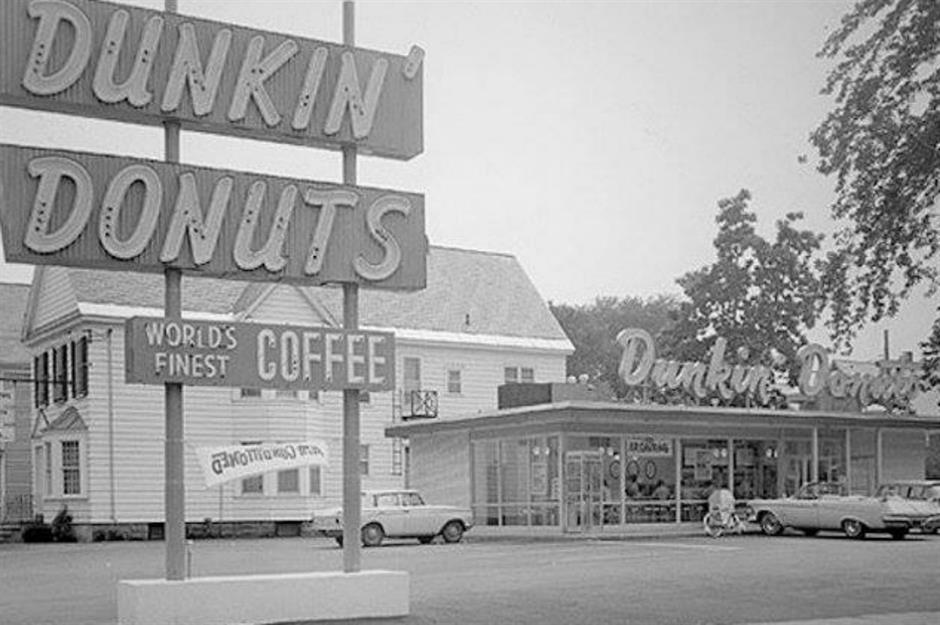
Burgers may be our first thought when it comes to fast food, but the purveyors of other popular foods weren’t far behind the quick-cook revolution. Baked goods got a boost when the first Dunkin' Donuts opened its doors in 1950 in Quincy, Massachusetts. The coffee company and quick-service restaurant has never looked back and now has more than 11,700 locations in 43 countries. The first-ever store is pictured here.
1950s: tacos to go
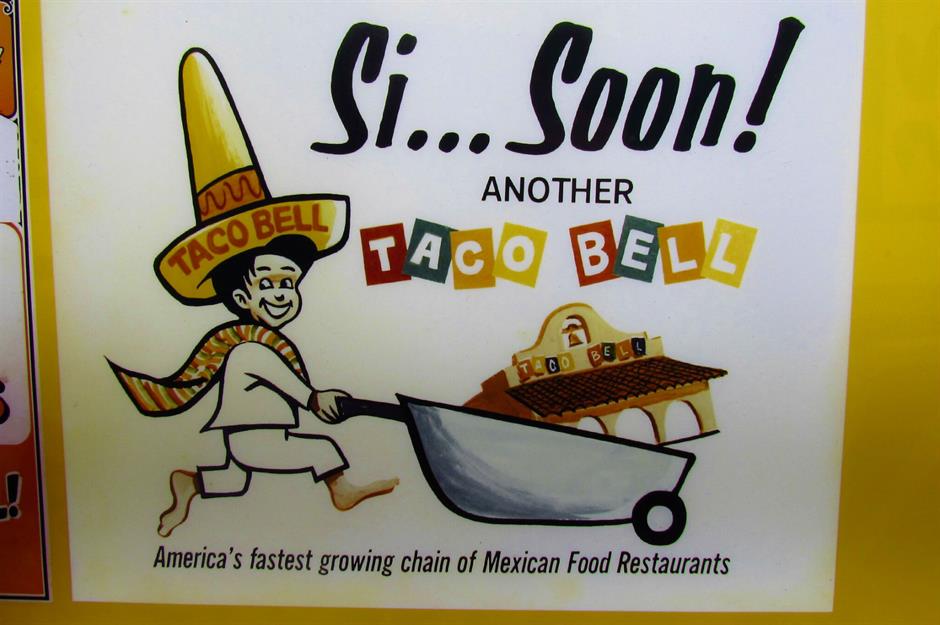
Glen Bell first opened a hot dog stand, Bell’s Drive-In, in San Bernardino, California in 1948. But the canny operator watched queues at a Mexican restaurant across the road and wanted a piece of the action. He convinced the restaurant owners to let him see the recipe for their famous taco. He took what he had learned and opened a new stand under the name of Taco-Tia in late 1951 or early 1952, and launched taco takeout on the world.
1950s: Fast food burgers come to Canada
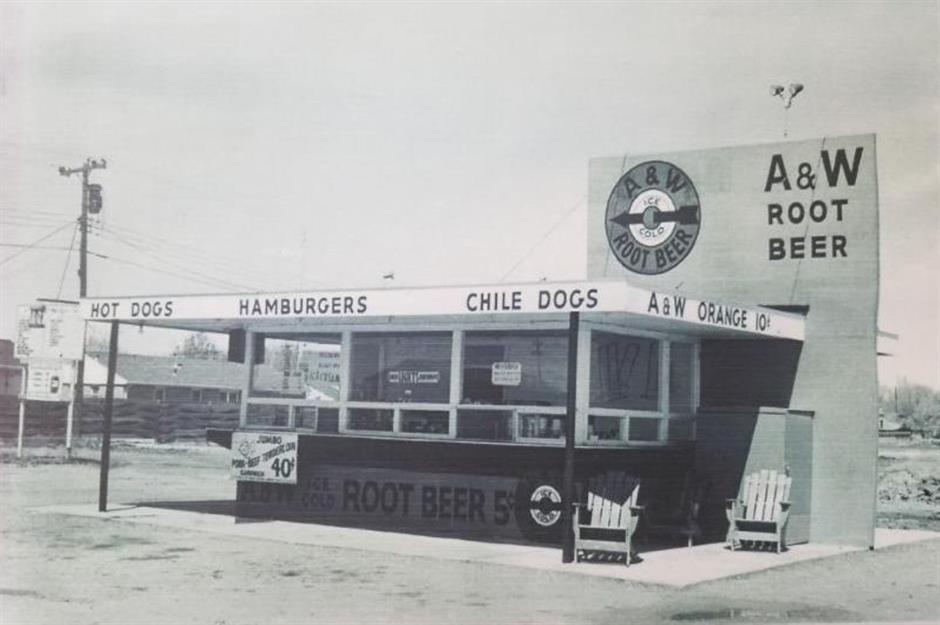
Canadians had to wait a little longer to get a taste of American-style fast food. A&W, which opened in Winnipeg, Manitoba, in 1956, was the country’s first fast food burger restaurant. The drive-thru chain had already established itself in the US, opening its first location in 1919, before expanding to Canada. The Canadian locations featured the signature root beer and classic burgers, but differentiated itself over time with dishes like poutine and deep-fried cheese curds. The success of A&W in Canada set the stage for other fast food giants like McDonald's, which opened its first Canadian location in Richmond, British Columbia, in 1967.
1950s: KFC – the first franchise
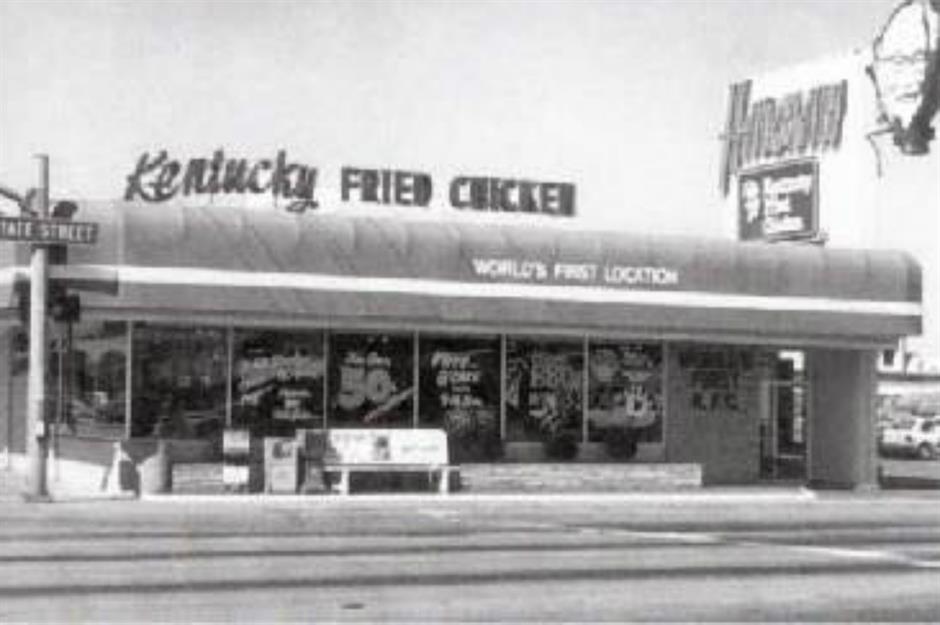
Little did Harland Sanders know that, when he started selling fried chicken at a service station in Corbin, Kentucky (pictured) during the Great Depression of the 1930s, his business would become the second-largest restaurant chain in the world. He perfected his still-secret recipe of herbs and spices in 1940 and, thanks to his inspired conversion of one of the first commercial pressure cookers into a pressure fryer, slashed the time it took to cook the chicken.
1950s: introducing the Colonel
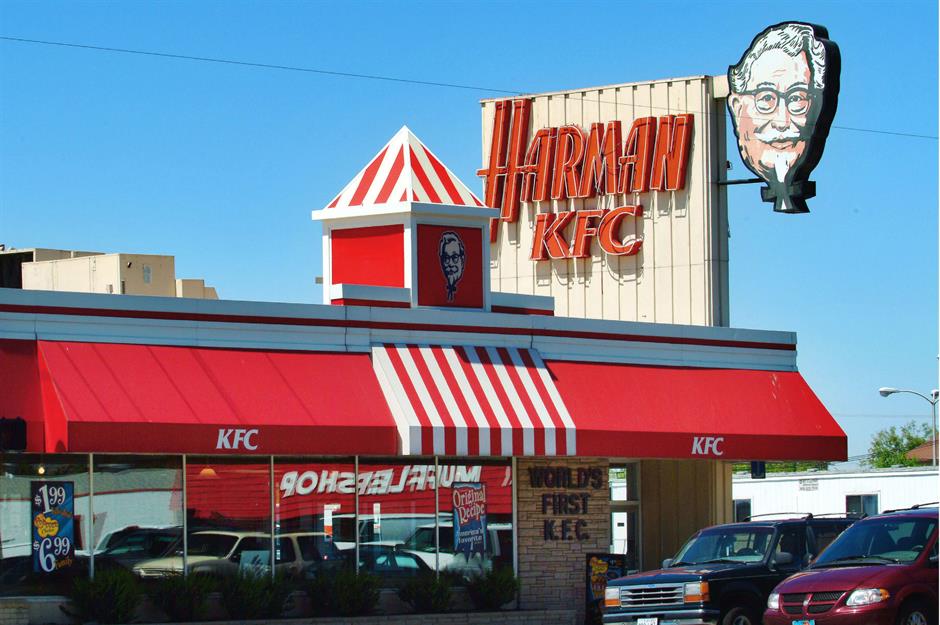
As well as challenging the burger’s dominance as fast food king, the Colonel, as Sanders would style himself, was the first to see the potential of the franchise. In 1952 he sold his chicken recipe to Pete Harman of South Salt Lake, Utah – the operator of one of the largest restaurants in the city.
1950s: finger lickin' good chicken
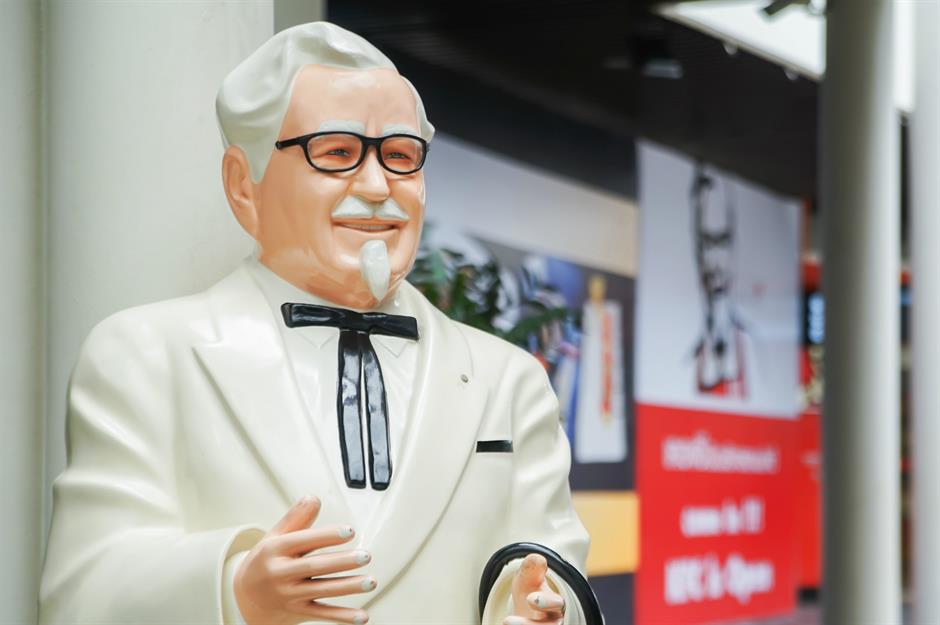
He would later travel across the US to market his chicken concept to restaurant owners, who paid four cents to him for each chicken sold in exchange for the recipe, method and rights to his image in the now-legendary white suit with goatee beard. Pete Harman, the first franchisee, coined the phrases 'Kentucky Fried Chicken' and 'It's finger lickin' good', which are recognised across the world today.
1950s: burgers, Canadian style
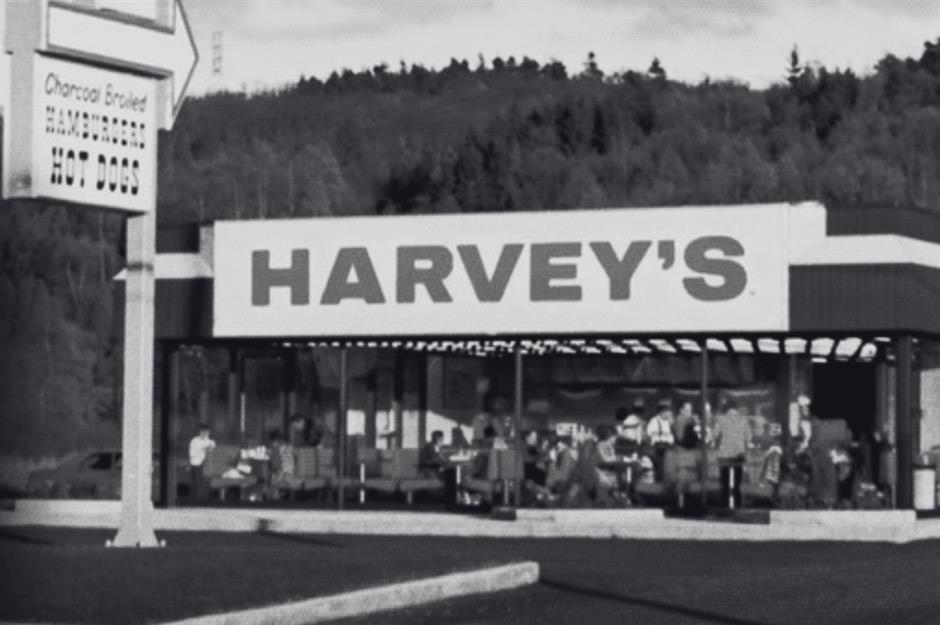
Meanwhile, over the border, Canada was developing its own unique twist on the fast food burger concept. Just a few years after the first Canadian A&W franchise opened in 1956, iconic fast food joint Harvey’s opened its first spot in Toronto, Ontario. Harvey’s instantly stood out from the competition with its smoky flame-grilled burgers, and also became famous for allowing customers to customise their burgers. The ‘build-your-own-burger’ concept was innovative at the time, and it remains a key part of the brand's identity.
1960s: a slice of the action
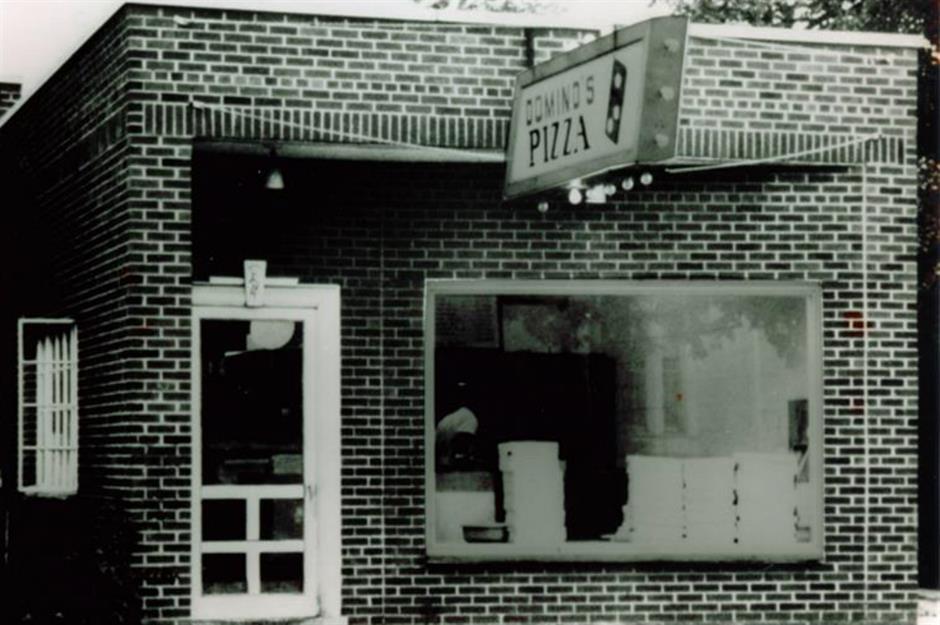
And we mustn't forget pizza. Soldiers stationed in Italy during World War II got a taste for it, so in search of speedy food on their return to New York, the city’s many Italian restaurants offered the first order-to-take-home pizzas. The home-delivery service would follow and, in 1960, Domino's (pictured) was born in Ypsilanti, Michigan, founded by brothers Tom and James Monaghan, who borrowed the investment money from their mother.
1960s: the first chicken sandwich

Nowadays, pretty much every fast food brand offers some kind of chicken sandwich, but back in the 1960s, serving a breaded, boneless chicken breast between two buttered buns was a real novelty. It was in 1964 that Chick-fil-A founder Truett Cathy first developed his legendary chicken sandwich. He’d been experimenting with the perfect recipe for years at the Dwarf Grill in Hapeville, Georgia, and the first Chick-fil-A restaurant (pictured) finally opened in 1967 at Atlanta's Greenbriar Mall. The chain was pretty slow to expand, only operating in malls until the first stand-alone spot was opened in 1986 in Atlanta.
1960s: sandwich superstars
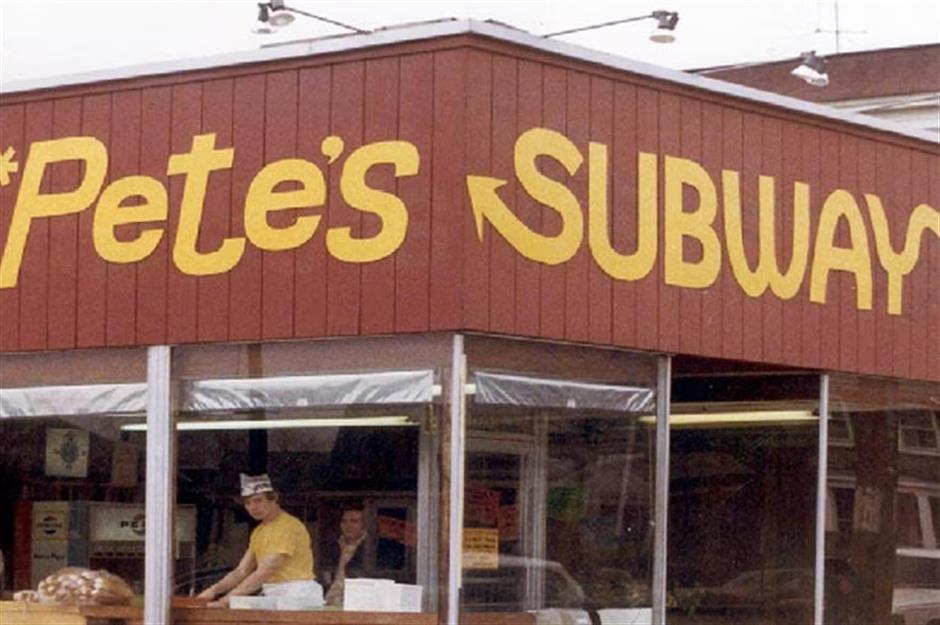
Today Subway is one of the world’s biggest fast food chains, but it all started in 1965, when 17-year-old Fred DeLuca needed to save up for medical school. Dr. Peter Buck, a family friend and nuclear physicist, lent him $1,000 to start a business, and Pete’s Super Submarines opened in Bridgeport, Connecticut. The idea was to provide a healthier, more affordable alternative to the traditional fast food options available at the time. In 1968, the duo rebranded the restaurant to Subway, which was simpler and more marketable, and by 1974, they had opened 16 outlets in Connecticut.
1960s: Canada’s coffee culture

Hot on the heels of the first Harvey’s restaurant, Canada launched another homegrown twist on a US fast food favourite: coffee and donuts. Tim Hortons was founded by professional hockey player Tim Horton in 1964 in Hamilton, Ontario, and it quickly became synonymous with the country's coffee culture. The introduction of iconic items like Timbits in 1976 and the famous Double-Double coffee solidified its place in the hearts of Canadians. These days, Tim Hortons is a global brand with over 5,500 locations across 13 countries.
1970s: McDonaldland is born
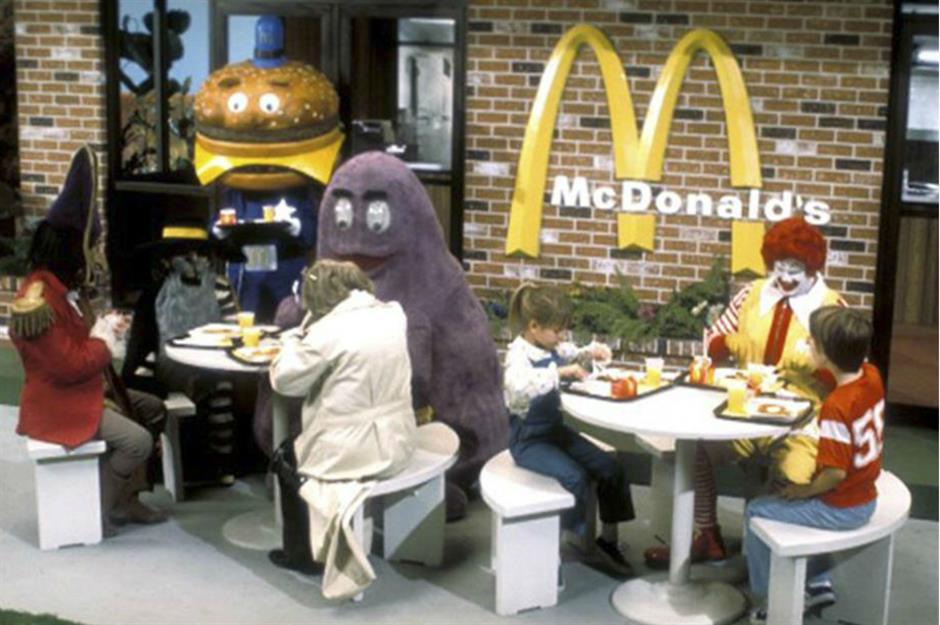
Children’s menus were established by many of the leading chains during the 1960s, with Ronald McDonald making his first appearance in adverts for McDonald’s in 1963. But the 1970s would see the marketing of visits to fast food restaurants, aimed at children and families, as fun excursions. McDonaldland and its cast of colourful characters – Hamburglar, Grimace, Mayor McCheese, Captain Crook and the Big Mac – made their first appearance in 1970.
1970s: doing it for the kids
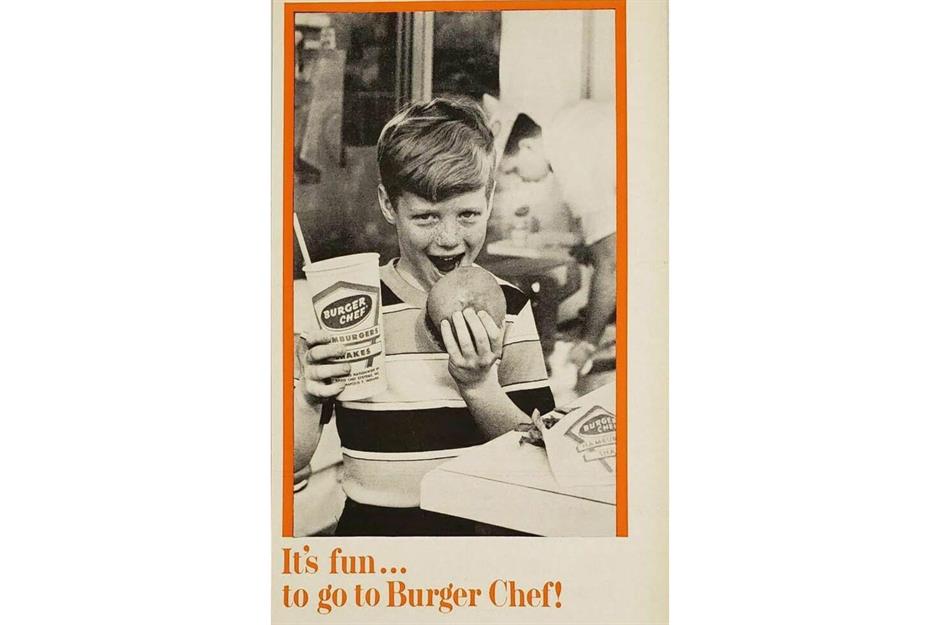
Most of us credit McDonald’s with inventing the kids' meal, but it was actually long-lost fast food chain Burger Chef that was first to serve boxes that bundled together a burger, dessert and toy. The Fun Meal was introduced in 1973 (predating the Happy Meal by six years) and its mascots were Burger Chef and his trusty sidekick Jeff. Other zany characters included a magician named Burgerini and a vampire named Count Fangburger. Founded in 1954 in Indianapolis, Indiana, Burger Chef was once America's second-largest burger brand, with almost as many locations as McDonald's – 1,200 at its peak in the 1970s.
1970s: the happy meal
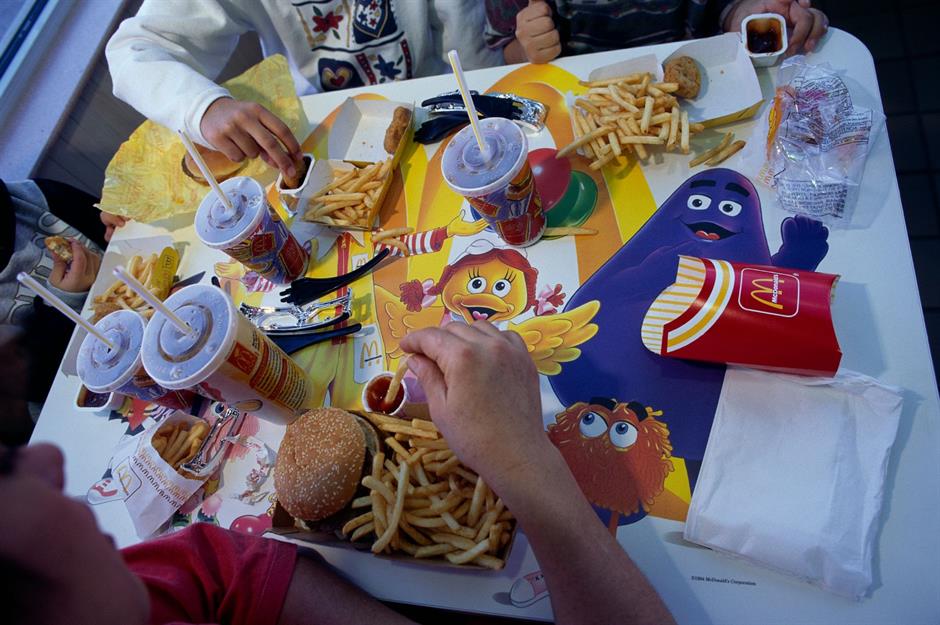
The McDonald’s Happy Meal entered the fray in 1979. The combo meal for kids – which typically included a hamburger, cheeseburger or chicken McNuggets, a side of fries, a child-friendly drink and a toy – came in a highly identifiable bright red box with McDonald’s super-smiley branding. And the kids are still lovin' it.
1980s: time to party
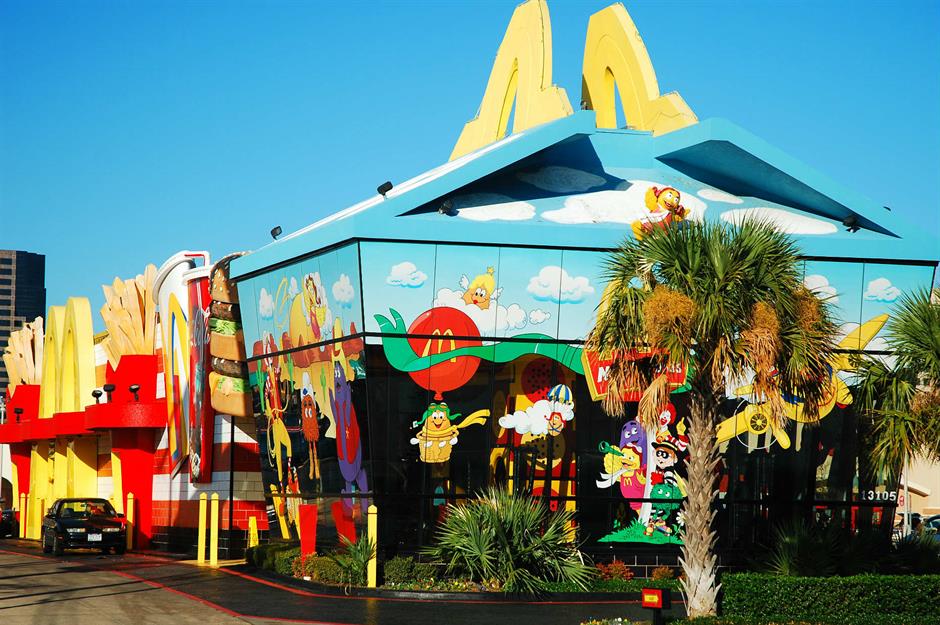
The Happy Meal's packaging and toy are frequently part of a marketing tie-in to a television show, film or toy brand. In fact, in 2011, McDonald's was said to be the world's largest distributor of toys. But it was the concept of the Happy Meal itself that would become iconic. So much so, a whole restaurant in Dallas, Texas took its much-loved form (pictured). The children’s birthday party package was also born – and endures to this day – serving up exclusive invites, Happy Meals, fun, games and even a visit from Ronald.
1980s: America goes super size
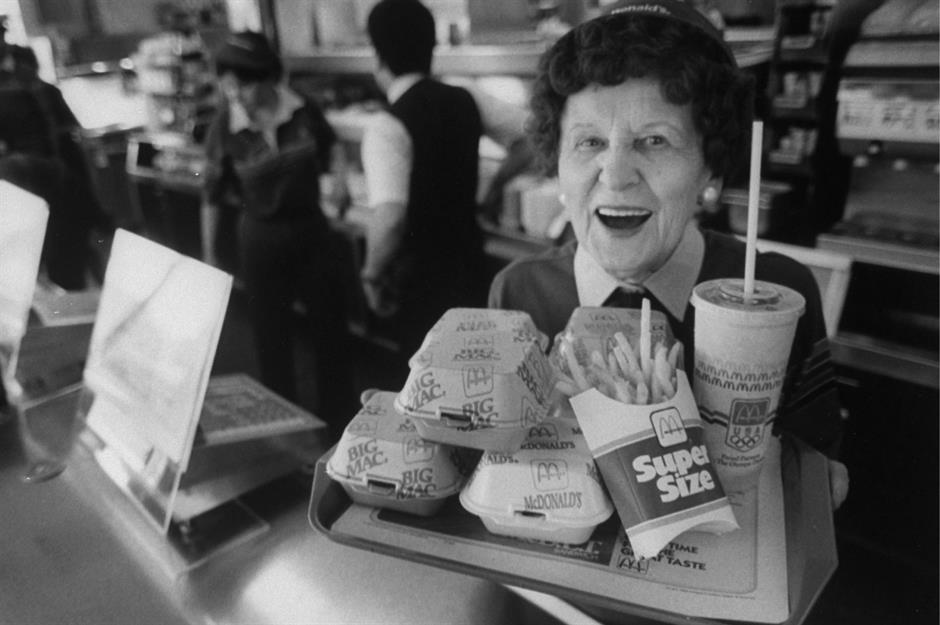
The 1980s were years of huge innovation in fast food, with many now-legendary dishes introduced. McDonald’s gave us the McRib in 1981 and Chicken McNuggets in 1983, Dairy Queen's Blizzard came on sale in 1985, and Pizza Hut’s Meat Lover's Pizza arrived in 1988. But one of the more controversial innovations was McDonald’s offering diners the option to ‘super-size’ their fries and soft drinks from 1987. The oversized upgrade was available for almost 20 years, but was phased out in 2004, partly due to criticism sparked by the award-winning documentary Super Size Me, which prompted widespread debate about public eating habits.
1980s: the Burger Wars begin
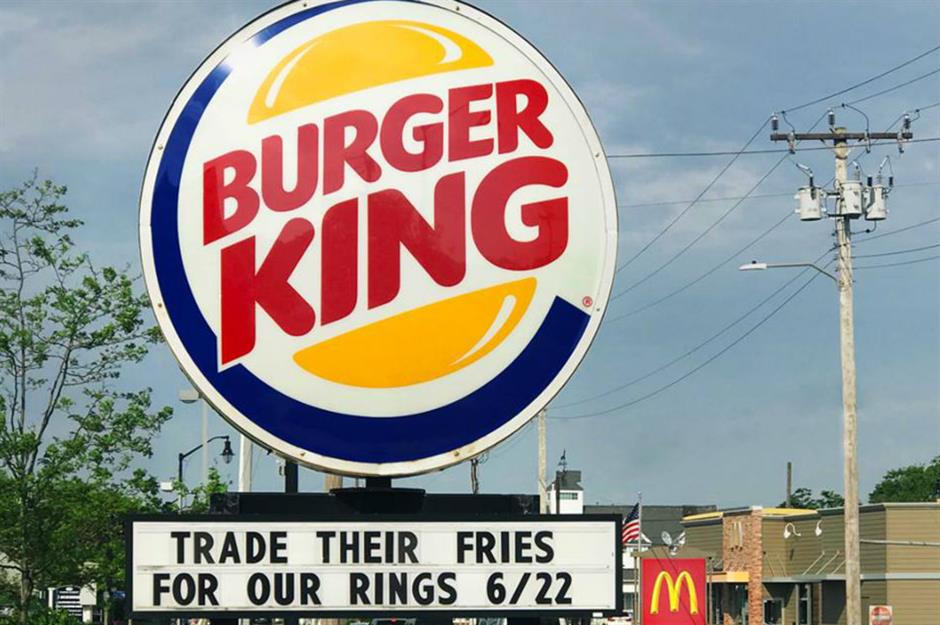
Fast food got serious and silly at the same time during the 1980s and 1990s. A period of aggressive advertising campaigns and price slashing kicked off the Burger Wars. These campaigns included high-profile TV adverts and press marketing that used a tactic known as comparative marketing – each chain comparing its product with its rival's and declaring theirs the best.
1980s: Burger King vs. McDonald's
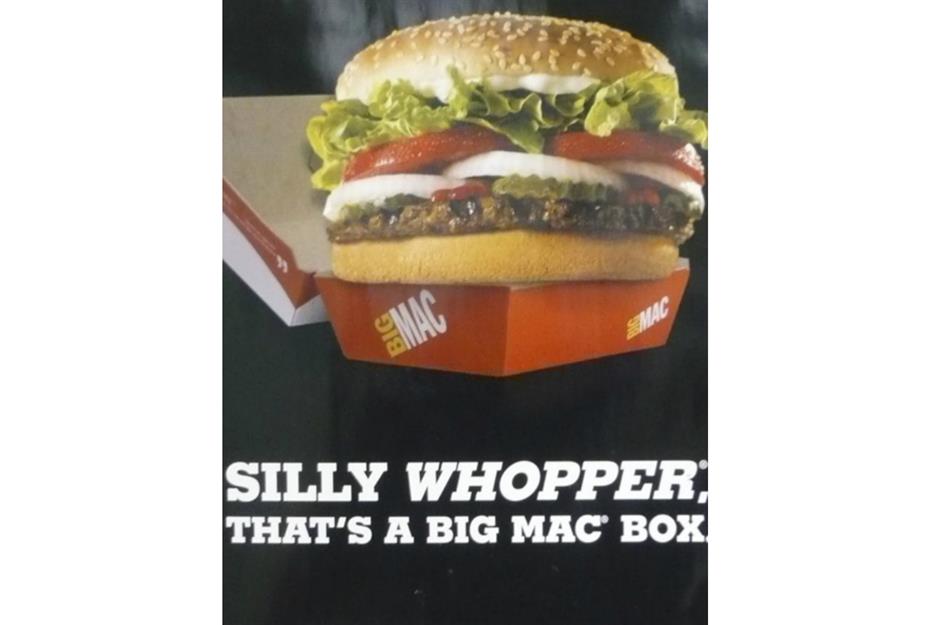
Burger King kicked things off with a concerted effort to overtake McDonald’s that would end up coming at a huge cost to both businesses. In the early 1980s, Burger King set out to emphasise that its burgers were flame-broiled rather than fried like McDonald’s patties. What followed was some of the biggest rival ad campaigns seen to date, costing the companies tens of millions of dollars and denting their profits.
1980s and 1990s: Wendy's enters the ring
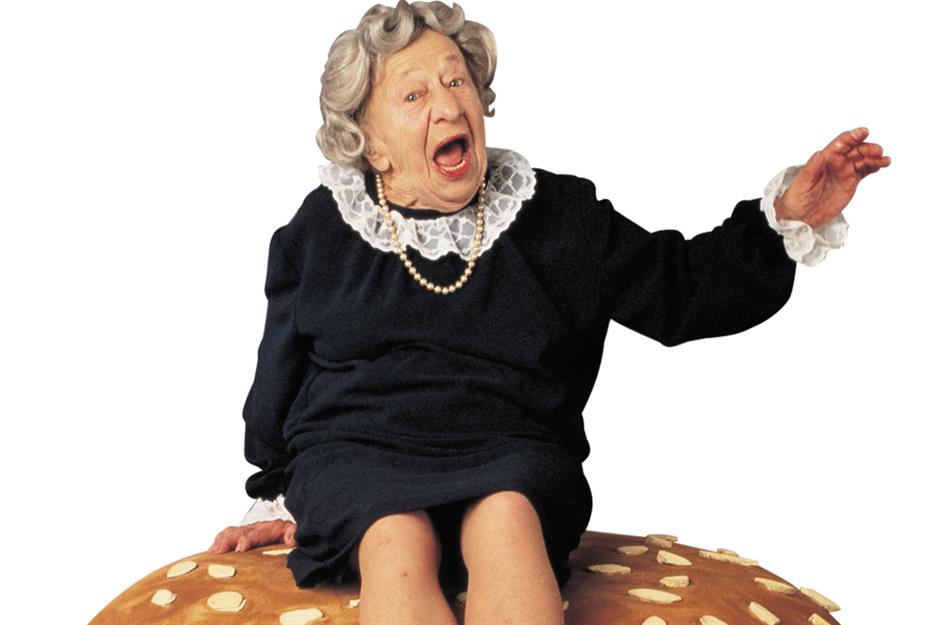
Founded in 1969 in Columbus, Ohio, Wendy's focused on the Old Fashioned Hamburger. The company entered the melee in 1984, branding itself as the 'fresh alternative' to its two biggest rivals and launching its hugely successful 'Where's the beef?' campaign. The TV advert, featuring old ladies literally looking for the beef in rival burgers, would see the then 81-year-old actress Clara Peller, pictured in character for the campaign, become an instant cultural icon.
1980s: where's the beef?
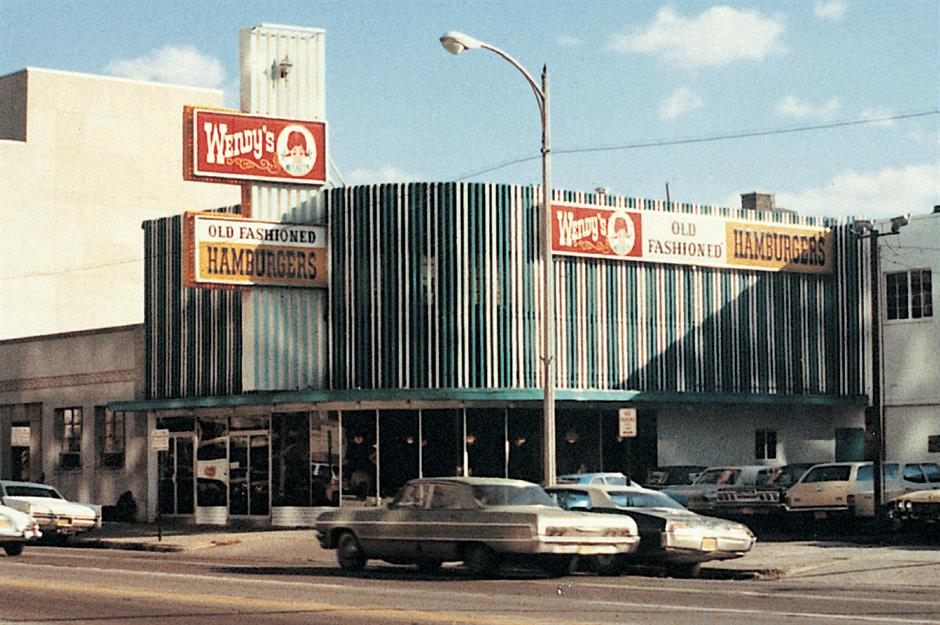
'Where's the beef?' also entered the American lexicon as a catchphrase for questioning authenticity, and we still use it today. The campaign's runaway success wasn't just a cultural moment to be remembered, either (although there was spin-off merchandise and even a song). Sales at Wendy's, whose first store is pictured, jumped 31% to $945 million in 1985 worldwide, proving you should never doubt the power of a great catchphrase.
1990s: McDonald's gets Canadianized
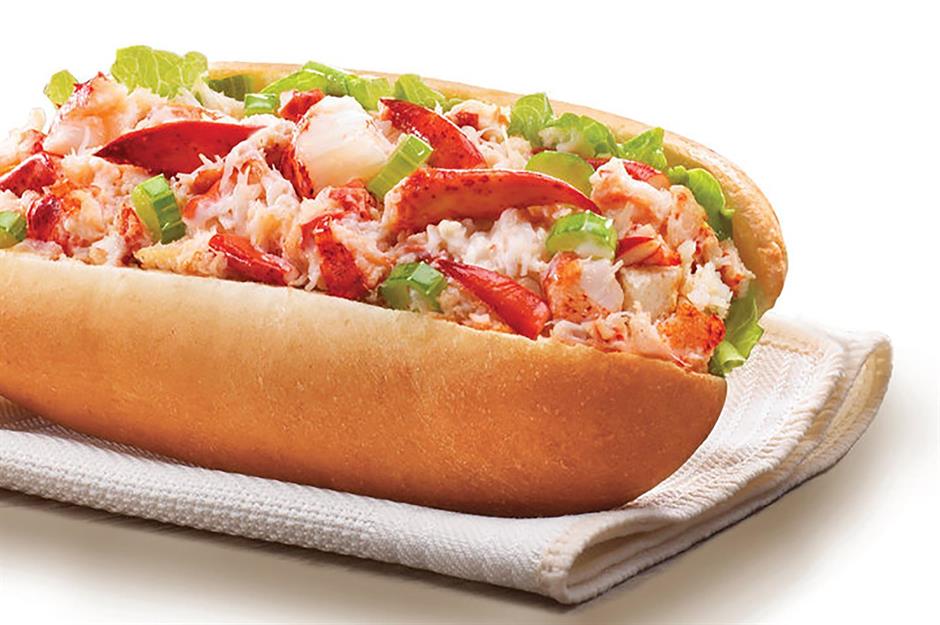
Up until this point in history the McDonald's menu was fairly consistent wherever you went in the world, but the 1990s heralded a new era of regional specials. In Canada, this meant the launch of the McLobster in 1993 – arguably the brand’s fanciest ever dish. It was available seasonally in Canada and New England, usually during summer, when lobsters are abundant. Surprisingly, it wasn’t until 2013 that poutine was finally added to the Canadian McDonald's menu.
1990s: Starbucks becomes a global phenomenon
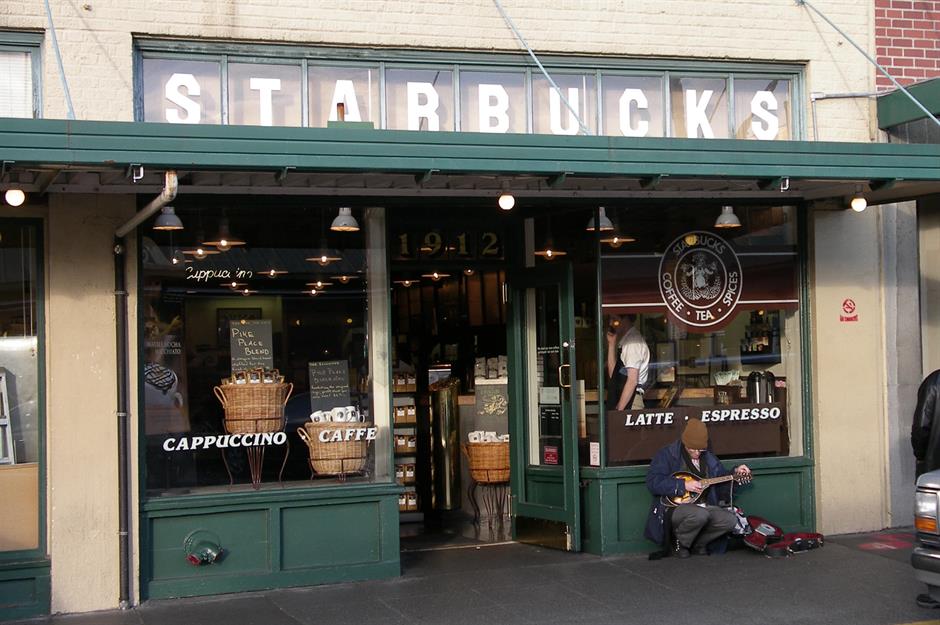
Diners and burger chains may have served Baby Boomers well, but times were a-changing. In 1971, three young partners founded a coffee shop in Seattle’s Pike Place Market to serve this new generation's needs – quality coffee and a social environment. It would take a stock market listing and another generational shift in the late 1990s and early 2000s for Starbucks to become a global phenomenon, but the coffee shop revolution had begun.
2000s: fast food shake up
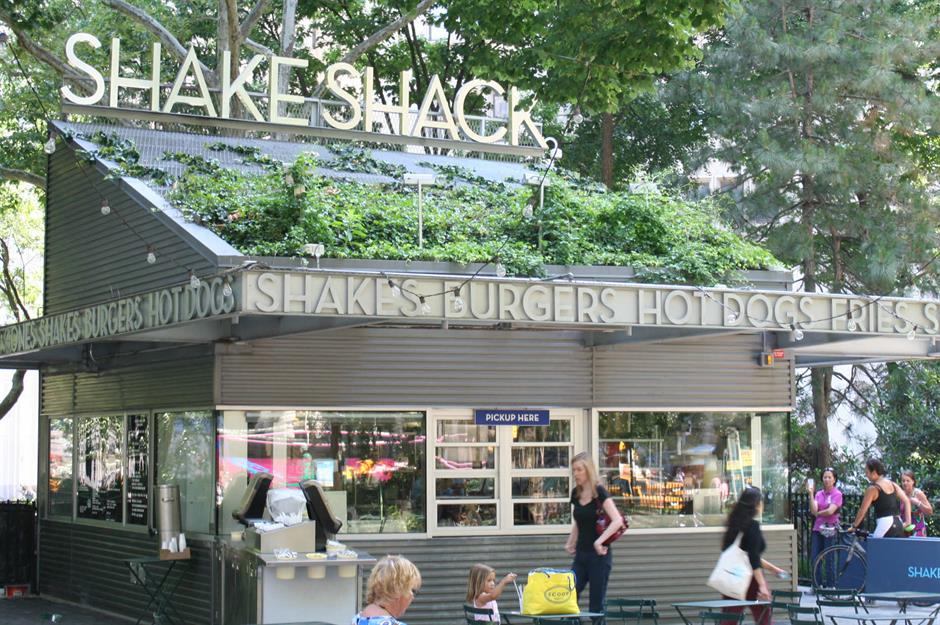
The public’s love affair with fast food was as strong as ever, but in the 2000s, customers were starting to think seriously about their health – perhaps none more so than hip New Yorkers. No wonder, then, that the founding of Shake Shack in 2004 (which started out as a hot dog cart in Madison Square Park before expanding to a kiosk in the same area), was a roaring success. Alongside its milkshakes, it served hamburgers and hot dogs that emphasised the use of natural, hormone and antibiotic–free Angus beef.
2000s: hot dogs go gourmet
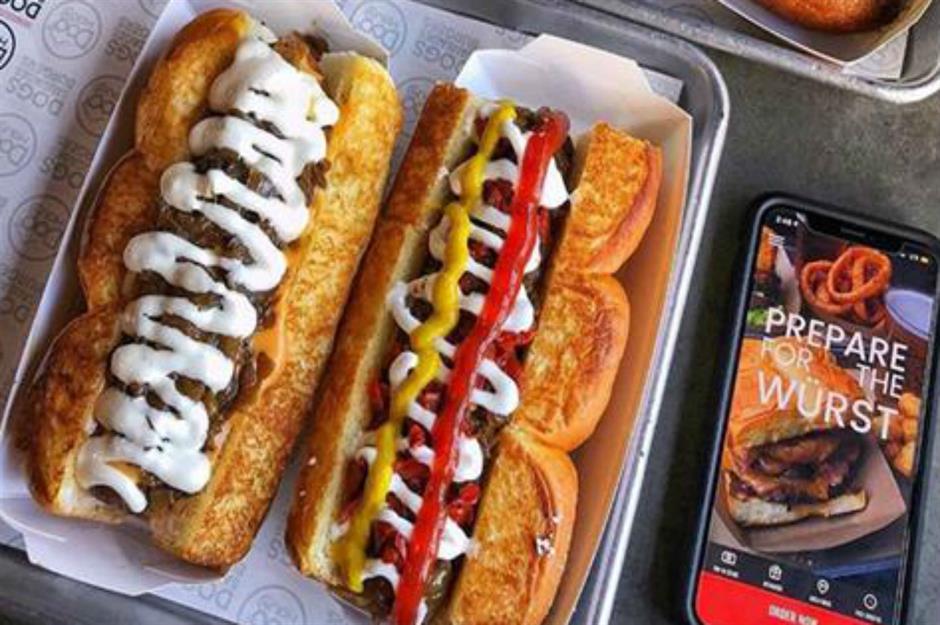
With health and authenticity-conscious millennials now forming a large share of the market, American fast food underwent an artisan revolution. Gourmet hot dog chain Dog Haus, founded in Pasadena, California in 2010, is a prime example. Its founders wanted to 'recapture the nostalgic childhood experience of eating a hot dog' using fresh ingredients. Dog Haus is known for its generously dressed sausage dogs and signature all-beef hot dogs.
2010s: plant-based sushi arrives

The march of fresh, environmentally friendly and healthy food was already unstoppable but, as meat began to find itself in the firing line, plant-based food became a major player. Guy Vaknin founded plant-based sushi chain Beyond Sushi in 2012, in New York, with phenomenal success. After an appearance on television’s Shark Tank, the brand's day-to-day sales exploded by 40%.
2010s: move over, meat
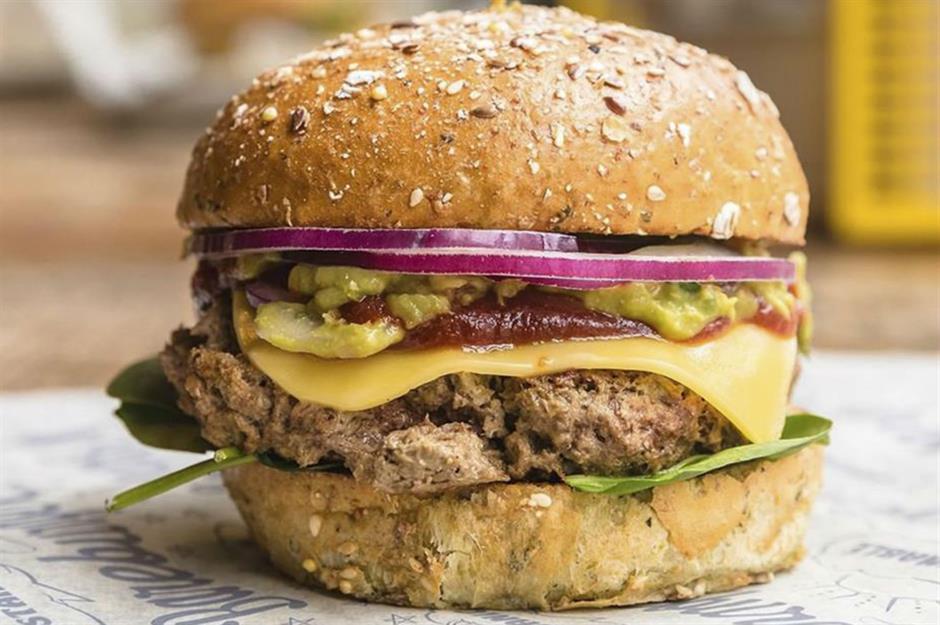
But the burger would not be left behind. The funky Bareburger chain was one of the first to start selling the Impossible Burger, a plant-based patty from Silicon Valley start-up Impossible Foods which 'bleeds' and sizzles when cooked, in 2017. The chain is an all-natural, organic burger outlet that sells beef and bison patties alongside quinoa, black bean and meat-free versions. What could be better than a yummy burger with a clear conscience?
2010s: meat-free goes mainstream
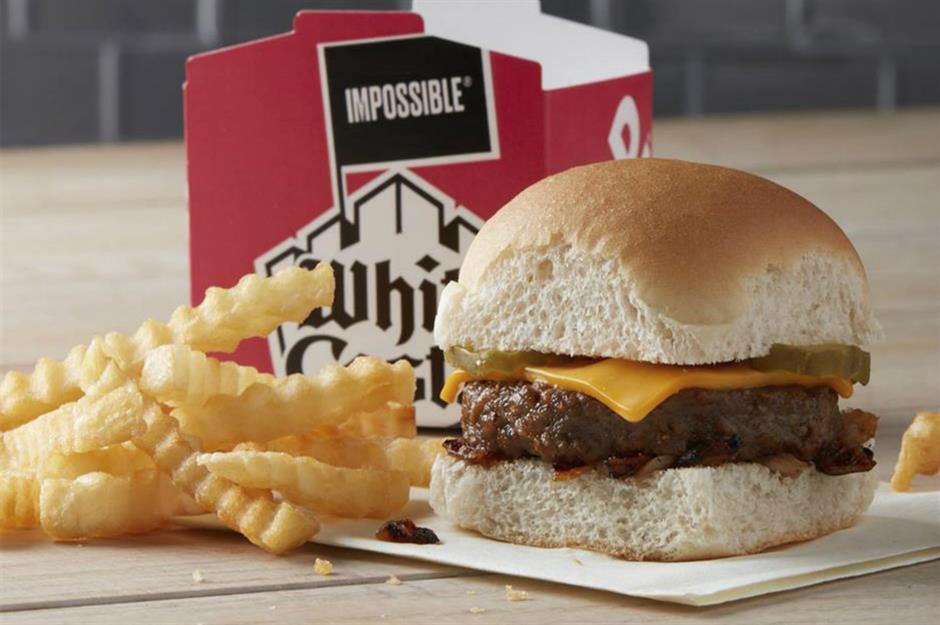
The Original Slider may be one of the world’s most important burgers, but White Castle stayed ahead of the curve when it introduced the Impossible Slider in 2018. At just $1.99 at the time, the plant-based burger offered an affordable way for burger lovers to minimise their environmental footprint. Of course, the major players weren’t far behind. The Impossible Whopper was introduced at Burger King in St. Louis, Missouri at the start of 2019 and was a resounding success, rolling out globally soon after.
2010s: exclusive eats
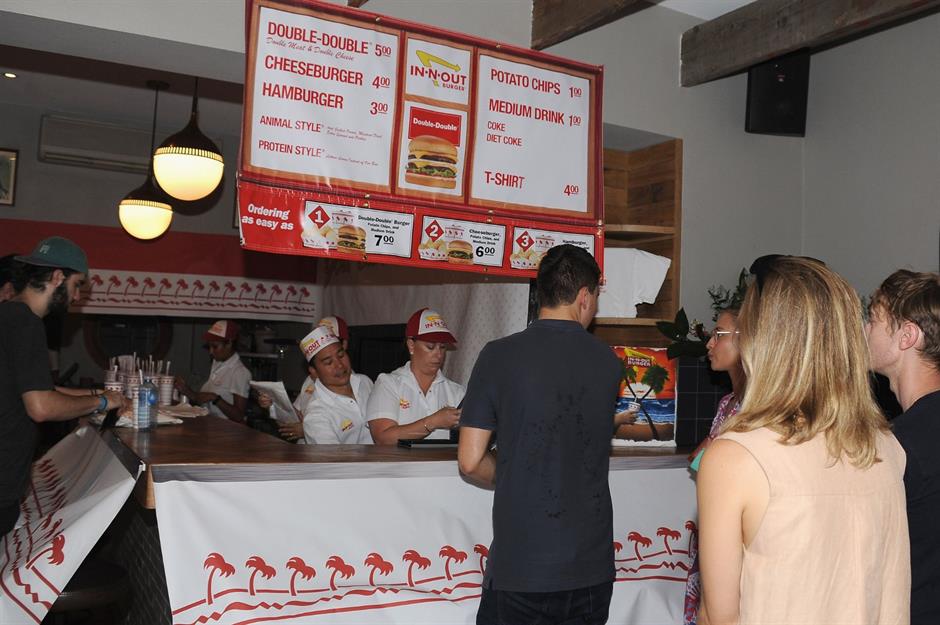
While the majority of fast food brands are obsessed with global domination, In-N-Out has become a cult favourite by using the opposite strategy and never opening a permanent restaurant outside of the US. The smart marketeers at In-N-Out certainly know how to keep global fans on their toes – its occasional international pop-ups regularly cause chaos. The first was in 2016 when the chain landed in London, UK. Fans waited in line for up to five hours, with some offering to pay £100 (around $125) for a wristband guaranteeing them a burger. Similar pop-ups have been held in Australia (pictured), Germany, the UAE, Japan and South Korea.
2020s: COVID-19 changes everything
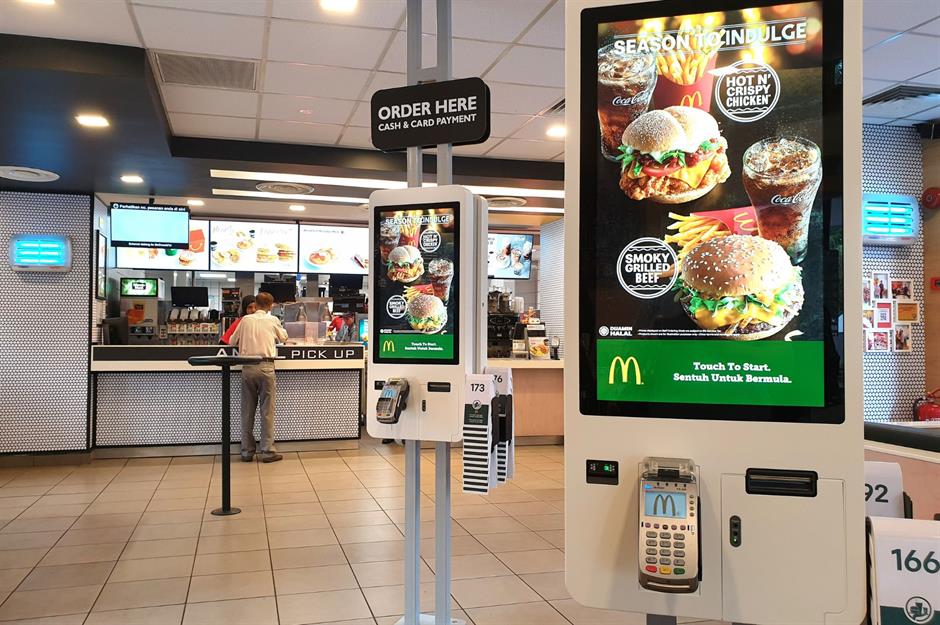
The COVID-19 pandemic had an enormous impact on the fast food industry all over the world – overnight, restaurants went from being consistently packed with diners to being forced to close their doors. Some of the changes (like reduced menus and social distancing) are long gone, but others have had a lasting impact on how we order and eat fast food. Tech-driven improvements like ordering via a mobile app, digital menu boards and self-service kiosks all boomed during the pandemic, and they appear to be here to stay.
Now take a look at these incredible photographs of drive-thrus through the ages
Comments
Be the first to comment
Do you want to comment on this article? You need to be signed in for this feature